Geography: Revision Test
MIGRATION
- Migration is the movement of people with the intention of setting permanently or temporary at a new location.
- When people move from one place to another, the place they move from is called the Place of Origin and the place they move to is called the Place of Destination.
- The place of origin shows a decrease in population while the population increases in the place of destination.
- It may be interpreted as a spontaneous effort to achieve a better balance between population and resources. It may be permanent, temporary or seasonal. It may take place from rural to rural areas, rural to urban areas, urban to urban areas and urban to rural areas.
- People migrate for a better economic and social life.
There are two sets of factors that influence migration:
- The Push factors make the place of origin seem less attractive for reasons like unemployment, poor living conditions, political turmoil, unpleasant climate, natural disasters, epidemics and socio-economic backwardness.
- The Pull factors make the place of destination seem more attractive than the place of origin for reasons like better job opportunities and living conditions, peace and stability, security of life and property and pleasant climate.
Effects of Migration
Migration can have a range of social, cultural, political and economic effects. It involves transfer of knowledge and skills, financial assets (including remittances), and the transfer of people from one location to another.
- The absence of young men in the areas of origin impoverishes agriculture and reduces crops yield.
- Migration also has consequences for the individual, the area of origin and the area of destination- on the family, household, society, the economy and development as a whole.
- The effect of international migration is not limited to remittances and cash inflows alone. It includes a wide range of development issues governance and legal protection, employment and social, protection, health services and education, tertiary education, knowledge and skills development, economic growth, financial services and growth, agriculture and rural infrastructural development, and environment issues.
- Sudden mass relocation or displacement has an adverse environmental effect on the migrant host area. This usually occurs directly when immigrants deforest expanse of land to set up human settlements or indirectly when the influx of immigrants to a community contributes to expansion and consequently gentrification and deforestation.
- The environmental impact of protracted overexploitation of natural resources, prolonged indiscriminate disposal of wastes, and other unwholesome environmental practices pose a significant hazard to the immigrants themselves and also to residents in proximity to such a settlement.
Migration occurs at a variety of scales
- Intercontinental (between continents),
- Intra-continental (between countries on a given continent), and
- Interregional (within countries).
Types of Migration
- Internal Migration: Moving to a new home within a state, country, or continent.
- External Migration: Moving to a new home in a different state, country, or continent.
- Emigration: Leaving one country to move to another (e.g., the Pilgrims emigrated from England).
- Immigration: Moving into a new country (e.g., the Pilgrims immigrated to America).
- Population Transfer: When a government forces a large group of people out of a region, usually based on ethnicity or religion. This is also known as an involuntary or forced migration.
- Impelled Migration (also called “reluctant” or “imposed” migration): Individuals are not forced out of their country, but leave because of unfavorable situations such as warfare, political problems, or religious persecution.
- Step Migration: A series of shorter, less extreme migrations from a person’s place of origin to final destination—such as moving from a farm, to a village, to a town, and finally to a city.
- Chain Migration: A series of migrations within a family or defined group of people. A chain migration often begins with one family member who sends money to bring other family members to the new location. Chain migration results in migration fields—the clustering of people from a specific region into certain neighborhoods or small towns
- Return Migration: The voluntary movements of immigrants back to their place of origin. This is also known as circular migration.
- Seasonal Migration: The process of moving for a period of time in response to labor or climate conditions.
Forms of Migration
- Rural-Urban Migration: this type of migration has to do with movement of people from the various villages to towns and cities
- Urban-Rural Migration: This refers to the movement of people from towns, cities to villages.
- Rural-Rural Migration: This is the movement people from one village to another village, this type of migration often occurs in areas where the soil is very fertile for agricultural purposes. Rural-rural migration may occur in villages where there is inter-tribal war and insecurities.
- Urban-Urban Migration: this is the movement of people from one city to another city.
India’s Migration Pattern: International Migration
Indians started migrating to West Indies after 1840 and their main destinations were Guinea and Trinidad. Each has over two lakh Indians. Some Indians had migrated to Jamaica. Martinique and Guadeloupe also. Most of the Indians migrated to these islands as labourers to work in the agricultural fields. Majority of such migrants were from Eastern Uttar Pradesh and Bihar. At present, Indians constitute over 50% of the population of West Indies.
Three waves of Indian Diaspora
There have been three waves of Indian Diaspora at three different times in the history of India. According to Migration Policy Institute, diaspora is defined as “people of Indian origin who live outside the country but continue to exhibit some of India’s ethnocultural characteristics.”
- The first wave took place during the British period when a large number of labourers were sent to Mauritius, Caribbean islands (Trinidad. Tobago and Guyana), Fiji and South Africa by British from Uttar Pradesh and Bihar; to Reunion Island, Guadeloupe. Martinique and Surinam by French and Dutch and by Portuguese from Goa, Daman and Diu to Angola, Mozambique to work as plantation workers. All such migrations were covered under the time-bound contract known as Girmit Act (Indian Emigration Act). These labourers were living in inhuman conditions and their living conditions were as bad as those of slaves.
- The second wave of migrants went to settle in the neighbouring countries like Thailand, Malaysia, Singapore, Indonesia, Brunei and some African countries. This is a recent development under which professionals, artisans, traders, factory workers went out of the country in search of better quality of life. This trend is still continuing. In the 1970s, there was oil boom in West Asia and a large number of skilled and semi-skilled workers went there to avail of the opportunity. Some entrepreneurs, store owners, professionals, businessmen etc. went to western countries also.
- The third wave started in 1960s and still continues to operate. In this period high profile professionals like doctors, engineers etc. migrated out of India. In 1980s, software engineers, management consultants, financial experts, media persons etc. moved out of the country to work in countries like the U.S.A., Canada, U.K., Australia, New Zealand, Germany etc. After liberalisation in 1991, education and knowledge based Indian migration has made Indian Diaspora most powerful in the world.
In-Migration
The present day population of India consists of descendants of people who migrated to this country at different pre-historic and historic times from different parts of the world. These include the Dravidians, the Aryans, Muslims, Mughals, Europeans, etc.
- Most of the international migrants in India are from the Asian countries, followed by Europeans, Africans, Americans and Australians. The maximum migration in India has taken place from the neighbouring countries like Pakistan, Nepal, Bangladesh and Afghanistan.
- Most of the immigrants in India from the neighboring countries mainly from Bangladesh and Nepal, are concentrated in Assam and Uttar Pradesh. Assam receives more Bangladeshis than the Nepalese while Uttar Pradesh has more Nepalese for the obvious reason of significance of distance factor in population migration. Foreign Nationals have settled in West Bengal, Maharashtra, Delhi, Tamil Nadu, Bihar, Punjab, Himachal Pradesh, Madhya Pradesh, Arunachal Pradesh, Odisha, Gujarat, Goa and Kerala.
- According to 2001 Census figures, more than 5 million persons have migrated to India from other countries. Out of these, 96 per cent came from the neighboring countries: Bangladesh (3.0 million) followed by Pakistan (0.9 million) and Nepal (0.5 million). Included in this are 0.16 million refugees from Tibet, Sri Lanka, Bangladesh, Pakistan, Afghanistan, Iran, and Myanmar.
Refugee Influx into India
- Although India has not signed the 1951 Refugee Convention, yet, India has been the main destination for refugees during the last about six decades and there has been a surge in refugees from the neighbouring countries like Tibet (China), Afghanistan, Sri Lanka, Myanmar and Bangladesh.
- The estimated figures say that there are more than 3 lakh refugees in India in 2011 making India one of the top 25 refugee recipients in the world. The following brief description gives an idea of refugee influx into India.
- Tibetans, Dalai Lama was allowed to set up a government in-exile at Dharamshala (Himachal Pradesh) in 1959. This brought in a wave of Tibetan refugees of them 80,000 have resident permits and are offered low paying public works jobs by the Indian government.
- Afghans: In 1979, about 90,000 Afghans fled to India when Soviet Union invaded that country In 1992 and afterwards, thousands of Afghanistanis took refuge in India when Taliban captured power in that country. In 2007, UNHCR estimated 9,200 Afghans in India and 4,000 asylum seekers in the process of refugee certification.
- Sri Lanka: The civil war in 1983 triggered first wave of Sri Lanka Tamil refugees to India by 1995 India. In 2008, 73,000 Sri Lankan refugees were living in 117 camps mostly in Tamil Nadu.
- Myanmar: 50,000 people fied from Myanmar to Mizoram in 2004 in the wake of military oppression. In 2017, nearly 40,000 Rohingyas muslims illegally entered into India from Myanmar.
- Bangladeshis: About 50,000 Chakma refugees fied Bangladesh to Tripura in 1988.
- Until December 2008, the Indian policy did not charge refugees a “visa or penalty tee” tor a residence permit. This was one or the main reasons of resurge of refugees into India. However, since then the numbers are dwindling. But thousands of Bangladeshis are sneaking illegally into India, making use of porous border between India and Bangladesh.
Reverse Migration
- The worldwide economic succession in 2008 forced a large number of Indian overseas to return to their home land. This reverse migration gathered momentum in 2008. An estimated 3 lakh Indian professionals working overseas are expected to return to India between 2011 and 2015.
- The sustained economic growth and the resilience that India had shown during the slowdown have fueled the reverse movement by those who had left the country in search of better job opportunities and higher standard of living.
India’s Migration Pattern: Internal Migration
- Historically, migration of people for work and education has been a phenomenon that accompanies the structural transformation of economies and has paved the way for release of “surplus labour” from relatively low- productive agricultural activities to sectors enjoying higher productivity (like industry, trade, transport etc.).
- The resulting remittance flows increase household spending in the receiving regions and further the economic development of less-developed regions.
- The patterns of flow of people are broadly consistent with popular conception—“less affluent states see more people migrating out while the most affluent states are the largest recipients of migrants.”
- India is increasingly on the move—and so are Indians. The study shows that annually inter-state labour mobility averaged 5-6 million people between 2001 and 2011, yielding an inter-state migrant population of about 60 million and inter-district migration as high as 80 million. The first-ever estimates of internal work-related migration using railways data for the period 2011-2016 indicate an annual average flow of close to 9 million people between the states. Both these estimates are significantly greater than in annual average number of about 3.3 million suggested by successive censuses and higher than previously estimated by any study.
- Migration is accelerating. In the period 2001-11, according to Census estimates, the annual rate of growth of labour migrants nearly doubled relative to previous decade, rising to 4.5 per cent per annum in 2001-11 from 2.4 per cent per annum in 1991-2001.
- While internal political borders impede the flow of people, language does not seem to be a demonstrable barrier to the flow of people.
Magnitude and Patterns of Migration
Net flows at the All-India level have averaged close to 9 million, peaking around 2013-14, considerably above level suggested by the Census.
- According to the Economic survey 2017, the largest recipient was the Delhi, Maharashtra, Tamil Nadu, Gujarat, Andhra Pradesh, Kerala, which accounted for more than half the migration, while Uttar Pradesh and Bihar taken together account for half of total out- migrants.
- Maharashtra, Goa and Tamil Nadu had major net in-migration, while Jharkhand and Madhya Pradesh had net out-migration.
- Largest recipient states attract large swathes of migrants from the Hindi heartland of Uttar Pradesh, Bihar, and Madhya Pradesh, Punjab, Rajasthan, Uttarakhand, J & K, West Bengal.
- Kolkata in West Bengal attracts migrants from nearby states of Jharkhand, Uttar Pradesh and Odisha making evident one of the laws of migration propounded by Ravenstein (1885)—“There is a process of absorption, whereby people immediately surrounding a rapidly growing town move into it and the gaps they leave are filled by migrants from more distant areas, and so on until the attractive force is spent”.
- There is an interesting dynamic between Gujarat and Maharashtra where Surat has started acting as a counter magnet region to Mumbai and attracts migrants from the neighbouring districts of Maharashtra. Other countermagnet region dynamics are observed in Jaipur and Chandigarh (to Delhi).
HUMAN SETTLEMENT
Settlements refer to the process of grouping of people & acquiring of some territory to build houses & also for their economic support. It also refers to any form of human habitation which ranges from a single dwelling to a large city. Settlements can broadly be divided into two types – rural and urban. Some basic differences between rural and urban areas in general:
- The major difference between rural and urban areas is the function. Rural areas have predominantly primary activities, whereas urban areas have domination of secondary and tertiary activities.
- Generally, the rural areas have low density of population than urban.

Rural Settlements
Geographers have suggested various schemes of classification, which can broadly be grouped under four categories:
Compact/Clustered Settlements:
- These settlements have closely built up area.
- Therefore in such settlements all the dwellings are concentrated in one central sites and these inhabited area is distinct and separated from the farms and pastures.
- Maximum settlements of our country come under this category. They are spread over almost every part of the country.
Semi- Compact/Semi-Clustered Settlement:
- The dwellings or houses are not well-knitted.
- Such settlements are characterized by a small but compact nuclear around which hamlets are dispersed. It covers more area than the compact settlements.
- These settlements are found both in plains and plateaus depending upon the environmental conditions prevailing in that area.
Hamleted Settlements:
- These types of settlements are fragmented into several small units.
- The main settlement does not have much influence on the other units.
- Very often the original site is not easily distinguishable and these hamlets are often spread over the area with intervening fields.
- This segregation is often influenced by social and ethnic factors.
Dispersed Settlements:
- This is also known as isolated settlements.
- Here the settlement is characterized by units of small size which may consist of a single house to a small group of houses. It varies from two to seven huts.
- Therefore, in this type, hamlets are scattered over a vast area and does not have any specific pattern.
Rural Settlement Patterns
- Pattern refers to geometrical form and shape of the settlement and different settlements have different types of pattern depending on the site and historical background of the settlement. The pattern of a settlement provides a picture of its shape and a distinct pattern gets its name i.e. linear elongated, square. etc.
- Pattern also refers to two dimensional geometrical arrangements of rural settlements in an area. Sometimes a rural settlement may not depict any geometrical shape and the pattern may be termed as non-geometrical. Thus, two patterns — geometrical and non-geometrical— are easily discernible on a large scale map.
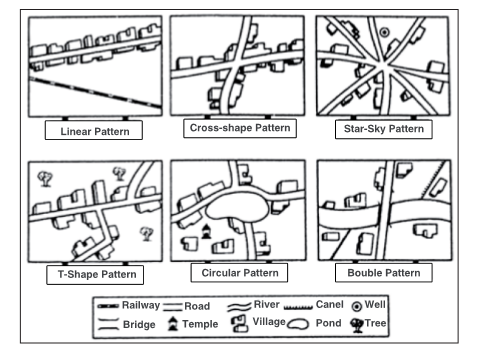
Morphology of Rural Settlements
- Morphology of rural settlements is concerned with their internal and external structure and identification, classification, regionalisation and analysation of its components. Thus rural morphology tries to find answers to meaningful basic questions like what is, where and why?
- Carl Sauer opines that rural morphology is based on three postulates viz. (i) organic or quasi-organic, (ii) functional equivalent and (iii) agglomeration and placement of structural elements.
- Thus, rural morphology deals with the study of built up area consisting of houses and streets etc. and the open land surrounding the built up area where agriculture or some other primary activity is carried on.
- The famous settlement geographer C.A. Doxiadis has suggested four main parts of rural settlements:
- Homogenous part, agricultural fields etc.
- Central part, built up area or Basti.
- Circulatory part, roads, streets, footpaths, etc.
- Special part, school, temples mosque, church, panchayat-ghar, cultural place, etc.
- The built-up area consists of houses, bazars (shops), streets, roads, schools, ‘religious places, cultural places, panchayat-ghar, etc. Almost all the rural settlements have built-up area at the centre which is surrounded by agricultural land or grazing land.
- These two types of area are connected to each other by Chak-roads, footpaths, etc. Normally the nucleus of the settlement is located on a higher site which is occupied by the first settlers (normally people belonging to upper castes or landlords locally known as Zamindars). Once the nucleus is properly inhabited, the village starts expanding around this nucleus with the passage of time.
Urban Settlements
- Unlike rural settlements, urban settlements are generally compact and larger in size. They are engaged in a variety of non-agricultural, economic and administrative functions. As mentioned earlier, cities are functionally linked to rural areas around them.
- Thus, exchange of goods and services is performed sometimes directly and sometimes through a series of market towns and cities. Thus, cities are connected directly as well as indirectly with the villages and also with each other.
- The definition of urban areas has been refined in 2011 according to which urban areas are comprised of two types of administrative units—Statutory Towns and Census Towns.
- Statutory Towns: All administrative units that have been defined by statute as urban like Municipal Corporation, Municipality, Cantonment Board, Notified Town Area Committee, Town Panchayat, Nagar Palika etc., are known as Statutory Towns.
- Census Towns: Administrative units satisfying the following three criteria simultaneously are treated as Census Towns as mentioned below:
- A minimum population of 5000;
- At least 75 percent of male working population engaged in non-agricultural sector; and
- A density of population of at least 4,000 persons per square kilometer
- City: Towns with population of 1,00,000 and above are categorised as cities.
- Out Growth: An Out Growth (OG) is a viable unit such as a village or a hamlet or an enumeration block made up of such village or hamlet and clearly identifiable in terms of its boundaries and location. Some of the examples are railway colony, university campus, port area, military camp, etc.
- Metropolitan Cities: Cities with population of one million and over are known as metropolitan cities. The main activities in these cities are industries, trade, commerce, transport, cultural and political. The number of metropolitan cities increased from 12 in 1981 to 53 in 2011.
- Mega Cities: Cities with population of 5 million and above are known as mega cities, according to Census of India. But United Nations considers mega cities as those that have a population of 10 million and above. In India, Greater Mumbai, Kolkata and Delhi are examples of mega cities.
- Conurbation: This term was coined by Patrick Geddes. It comes into being by coalescence of urban settlements which were separated by open space in the past. The coalescence usually occurs through Ribbon Development along the main inter-urban transport routes. Mumbai, Delhi and Kolkata are good examples of conurbations in India.
- Megalopolis: It is a Greek word which is derived by combining two terms ‘great’ and ‘city’. It is just like conurbation and is formed when a large city of Boston to sprawls and brings into its fold, the smaller adjacent towns and cities. This term was first used by Gottman in 1964 to describe the urban scene of the north-eastern board of the U.S.A. He identified a large conurbation like mass of linked built-up areas (and yet containing much more open land) extending Cities. The over 960 km (600 miles) from north of Boston to Norfolk in Virginia.
Urbanisation in India
The process of society’s transformation from a pre-dominantly rural to a predominantly urban population is known as ‘urbanisation. It includes two things— an increase in the number of people living in urban settlements, and an increase in the percentage of the population engaged in non-agricultural activities, living in such places.
-
- Trends in urbanistion in India from 1901 to 2011: Number of towns/urban agglomerations increased by more than four times from 1,915 in 1901 to 7,935 in 2011.
- There was steady increase in number of towns till 1951, but due to more rigorous tests applied in 1961 to determine whether a place qualified to be treated as a town or not, many urban places were declassified and hence, the number of towns declined from 3,035 in 1951 to 2,657 in 1961.
- Since the 1961 census, however, the urban population and number of towns/urban agglomerations had increased steadily. There has been more than three times growth in urban population in four decades which increased from 109.11 million in 1971 to 377.11 million in 2011.
Concept of Smart Cities
- 90% of the world’s urban population growth will take place in developing countries, with Indian taking a significant share of that. Urban areas also contribute a higher share of the GDP. The share of the GDP from urban areas in India has been growing.
- While the urban population is currently around 31% of the total population, it contributes over 60%, of India’s GDP. It is projected that urban India will contribute nearly 75% of the national GDP in the next 15 years. It is for this reason that cities are referred to as the “engines of economic growth” and ensuring that they function as efficient engines is critical to our economic development.
- This trend of urbanization that is seen in India over the last few decades will continue for some more time. The global experience is that a country’s urbanization upto a 30% level is relatively slow but the pace of urbanization speeds up thereafter, till it reaches about 60-65%. With an urban population of 31%, India is at a point of transition where the pace of urbanization will speed up.
What is a smart city?
- Smart Cities are those that are able to attract investments. Good infrastructure, simple and transparent online processes that make: it easy ‘to establish an enterprise and run it efficiently are important features of an investor friendly city. Without this a city loses attraction as an investment destination. An investor is considered as someone who helps a city rather than someone who only profits from it.
Pillars of a Smart City
Essentially, its Institutional Infrastructure (including Governance), Physical Infrastructure and Social Infrastructure constitute the three pillars on which a city rests; the center of attention for each of these pillars is the citizen. In other words, a Smart City works towards ensuring the best for its entire people, regardless of social status, age,” income levels, gender, etc.
- Institutional Infrastructure: Institutional Infrastructure refers to the activities that relate to the planning and management systems in a city. The new technology has provided a new dimension to this system making it efficient and transparent. It includes the systems of governance the sense safety and security, the opportunities for entertainment and ions, the open spaces and parks that are available.
- Physical Infrastructure: Physical infrastructure refers to its stock of physical infrastructure such as the urban mobility system, the housing stock, the energy system, the water supply system, sewerage system, sanitation facilities, (solid waste management system, drainage system, etc.) which are all integrated through the use of technology.
- Social Infrastructure: Social Infrastructure relates to those that work towards developing the human and social capital, such as the educational, healthcare, entertainment; etc systems. It would include the following:
- Education: The city should have good quality educational facilities both for schooling and higher education.
- Healthcare: High quality healthcare facilities are important factors in making a city livable and attractive for people and businesses.
- Entertainment: Good entertainment facilities make the people in a city happy. Good sports facilities, cultural centers, open spaces and plazas allow opportunities for recreation, so important for healthy and happy living.
Smart City Mission
- There is no universally accepted definition of a smart city and it may mean different things to different people. The concept of smart city can vary from people to people, city to city and country to country.
- The smart city mission of Government of India focuses on promoting the cities that provide core institutional, physical, social and economic infrastructure; give their dwellers a decent quality of life; sustainable environment and smart solution.
- Ministry/Department: Ministry of Urban Development (in collaboration of states)
- Objective: To develop 100 cities all over the country making them citizen friendly and sustainable
- Schemes:
- Smart cities to be selected through City Challenge Competition
- These cities to be developed as satellite towns of larger cities and by modernizing the existing mid- sized cities.
- Eight critical pillars of India’s Smart City Program are:
- Smart Governance
- Smart Energy
- Smart Environment
- Smart Transportation
- Smart IT & Communications
- Smart Buildings
- Smart Health Hospitals
- Smart Education
- The 100 potential smart cities were nominated by all the states
- 4 approaches are adopted for development of Smart Cities:
- Retrofitting i.e. city improvement: Introduce planning in an existing built-up area to achieve smart city objectives, along with other objectives, to make the existing area more efficient and livable. In retrofitting, an area consisting of more than 500 acres will be identified by the city in consultation with citizens. Redevelopment i.e. city renewal: Replacement of the existing built-up environment and enable co-creation of a new layout with enhanced infrastructure using mixed land use and increased density.
- Redevelopment envisages an area of more than 50 acres, identified by Urban Local Bodies (ULBs) in consultation with citizens.
- Greenfield development: Introduce most of the Smart Solutions in a previously vacant area (more than 250 acres) using innovative planning, plan financing and plan implementation tools (e.g. land pooling/ land reconstitution) with provision for affordable housing, especially for the poor. Ex. GIFT City
- Pan-city development envisages application of selected Smart Solutions to the existing city-wide infrastructure.
Massive reserves of mercury hidden in permafrost
Context
Researchers have discovered permafrost in the northern hemisphere stores massive amounts of natural mercury, a ?nding with signi?cant implications for human health and ecosystems worldwide.
About:
- Researchers from American Geophysical Union have discovered permafrost in the northern hemisphere which stores massive amounts of natural mercury.
- The study revealed that northern permafrost soils are the largest reservoir of mercury on the planet, storing nearly twice as much mercury as all other soils, the ocean and the atmosphere combined.
- Thawing of permafrost due to global warming can release mercury into ocean and can impact ecosystem in different ways.
- Mercury accumulates in aquatic and terrestrial food chains, and has harmful neurological and reproductive effects on animals.
Advantages:
- If mercury reserve found in permafrost can be exploited, it can serve humanity.
- Mercury is the only metal which is in liquid state at room temperature and has high coef?cient of expansion.
- Mercury is still used for the manufacture of industrial chemicals and for electrical and electronic applications.
Disadvantages:
- If the mercury is transported across waterways, it could be taken up by microorganisms and transformed into methyl mercury.
- This form of mercury is a dangerous toxin that causes neurological effects in animals ranging from motor impairment to birth defects.
- This is called Minamata disease, or Chisso-Minamata disease, which is a neurological syndrome caused by severe mercury poisoning.
India joined IEA Bioenergy TCP
About:
Bioenergy:
- Bioenergy is one of many diverse resources available to help meet our demand for energy. It is a form of renewable energy that is derived from recently living organic materials known as biomass, which can be used to produce transportation fuels, heat, electricity, and products.
- International Energy Agency’s Technology Collaboration Programme on Bioenergy (IEA Bioenergy TCP)
- International Energy Agency’s Technology Collaboration Programme on Bioenergy (IEA Bioenergy TCP) is an international platform for co-operation among countries with the aim of improving cooperation and information exchange between countries that have national programmes in bioenergy research, development and deployment.
- IEA Bioenergy TCP works under the framework of International Energy Agency (IEA) to which India has “Association” status since 30th March, 2017.
- The primary goal of joining IEA Bioenergy TCP by Ministry of Petroleum & Natural Gas (MoP&NG) is to facilitate the market introduction of advanced biofuels with an aim to bring down emissions and reduce crude imports.
- IEA Bioenergy TCP also provides a platform for international collaboration and information exchange in bioenergy research, technology development, demonstration, and policy analysis with a focus on overcoming the environmental, institutional, technological, social, ‘and market barriers to the near-and long-term deployment of bioenergy technologies.
- The R&D work in IEA Bioenergy TCP is carried out carried out within well-de?ned 3-years programmes called “Tasks”. Each year the progress of the Tasks is evaluated and scrutinized and each 3 years the content of the Tasks is reformulated and new Tasks can be initiated.
- Technical persons from Public sector Oil marketing companies will also be contributor in the Tasks participated by MoP&NG.
Signi?cance:
- It will give a boost to India’s commitment to harness 227 GW of Renewable energy by 2020 (Previously it was 175 GW).
- India has vast potential to develop bioenergy as it is 10th richest country in terms of forest cover.
- India has also largest cattle population in the world which are producers of biomass as byproducts which can be used to harness bioenergy.
- A part from it India’s crop residues can be used to produce this renewable form of Energy.
- International collaboration in terms of R&D and technology transfer will also help India to grow in this sector.
India and the Global Compact for Migration
Context
The Global Compact for Safe, Orderly and Regular Migration, a non-binding agreement for the better management of migration, was adopted by the United Nations member countries.
About:
- The major goal of the Global Compact for Migration is to assist nation states to frame well-managed migration policies.
- India is not a signatory to the UN Refugee Convention of 1951 or the 1967 Protocol, which protects refugee rights.
- Hence, signing of global compact of migration is a better step by India as it is one of the worst hit countries by illegal migration and is also the world’s largest contributor of migrant workforce.
Global Compact for Migration
- It is a non-binding agreement, which aims for Safe, Orderly and Regular Migration (GCM) aims to better manage migration at local, national, regional, and global levels, including reducing the risks and vulnerabilities that migrants or refugees face at different stages of their journey.
- Despite its non-binding nature, the adoption of the compact has led to a wide range of discussions within and outside parliaments, especially in receiving states.
- Out of the 193-member states, 164 countries have adopted the compact.
Implications on India of migration treaties:
- Among the emigrant countries, India receives the highest amount of remittance per year. The World Bank classi?es India as one of the top emigrating countries in the world, and the Indian diaspora is identi?ed as the largest in the world.
- Simultaneously, India has witnessed immigration to the country over the years, especially from neighboring countries.
- Another stream is the internal migration within India. But, the Indian state’s approach towards all three streams of migration is not explicit in nature and the management of migration is ill-developed as compared to other major sending and receiving countries.
- There is no balanced migration policy in the country which has led India to face criticism over the migration issue.
Signi?cance:
- By signing global compact for migration, India will ensure its emigrants safety and will draft a migration policy with the help of GCM (Global Compact for Migration).
- India has a long history of immigration from Tibet, Bangladesh, Sri Lanka, Pakistan, Afghanistan and recently Myanmar.
- India has also internal migration from eastern and North-eastern states to western and North-western states. Hence, India needs a migration policy to counter these problems.
- India’s limited natural resource has been overburdened by its population explosion and regular illegal immigration. A migration policy will help to manage migration issues in a better way.
LIGO
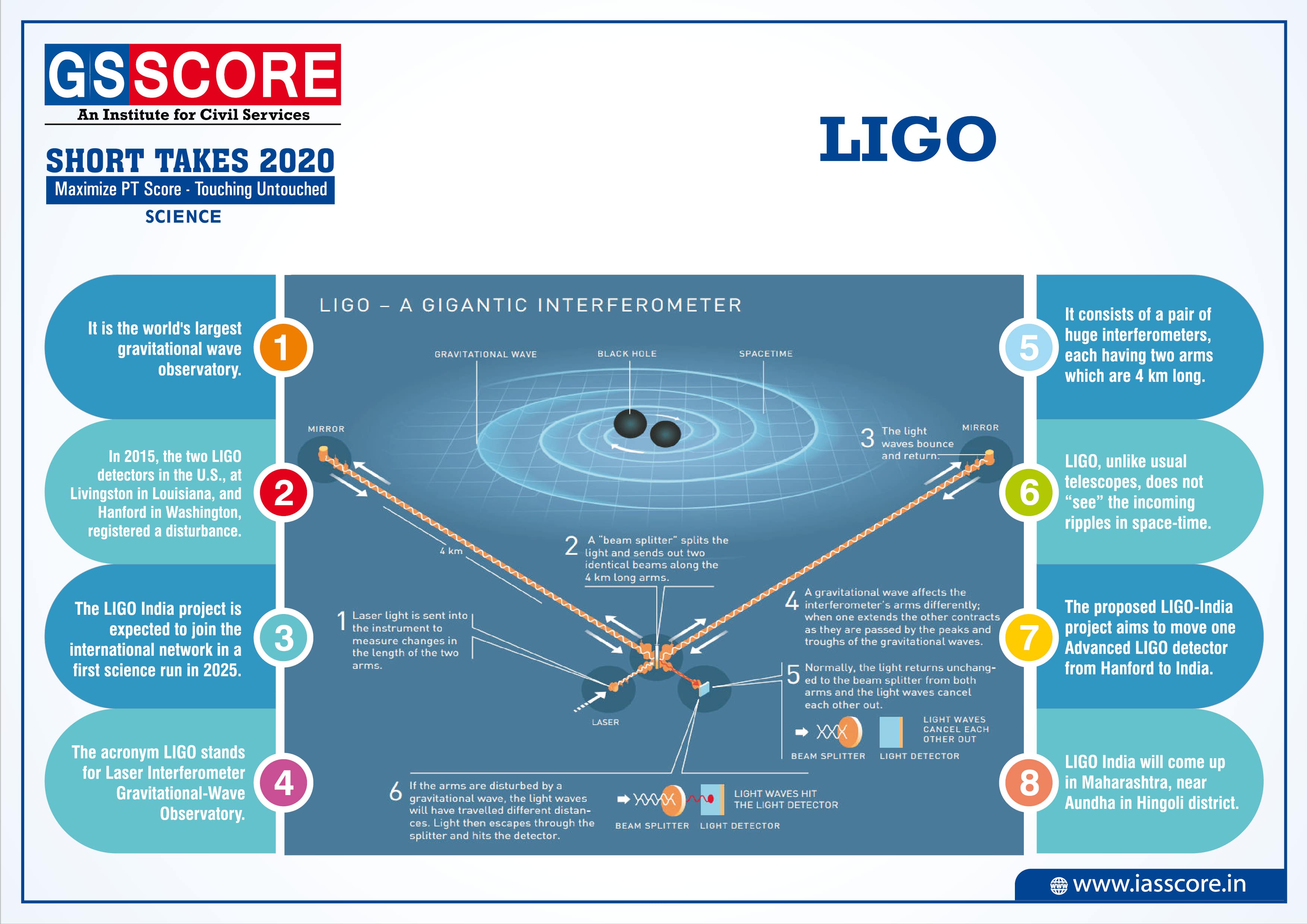
ASRAAM
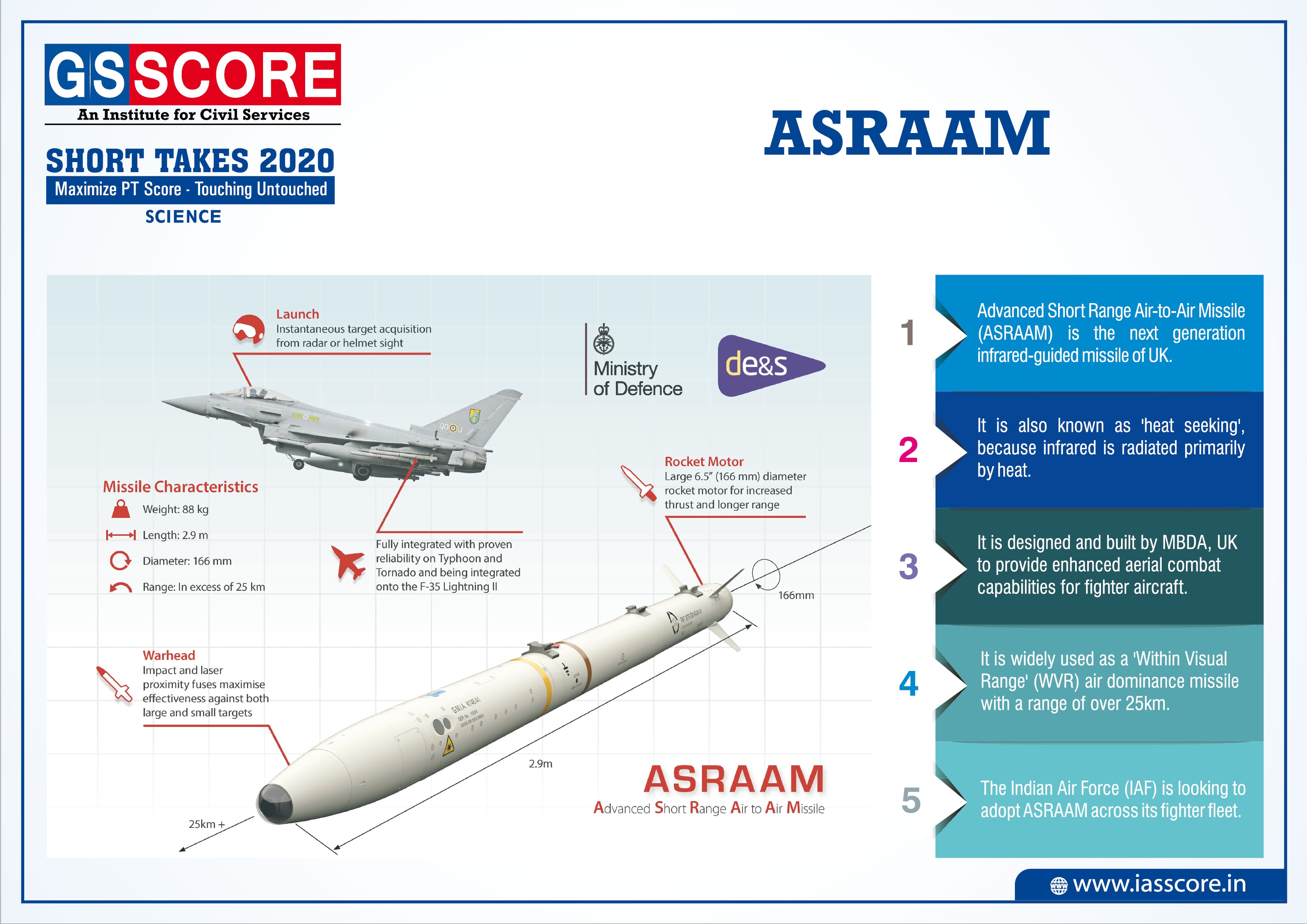
Defence Industrial Corridor
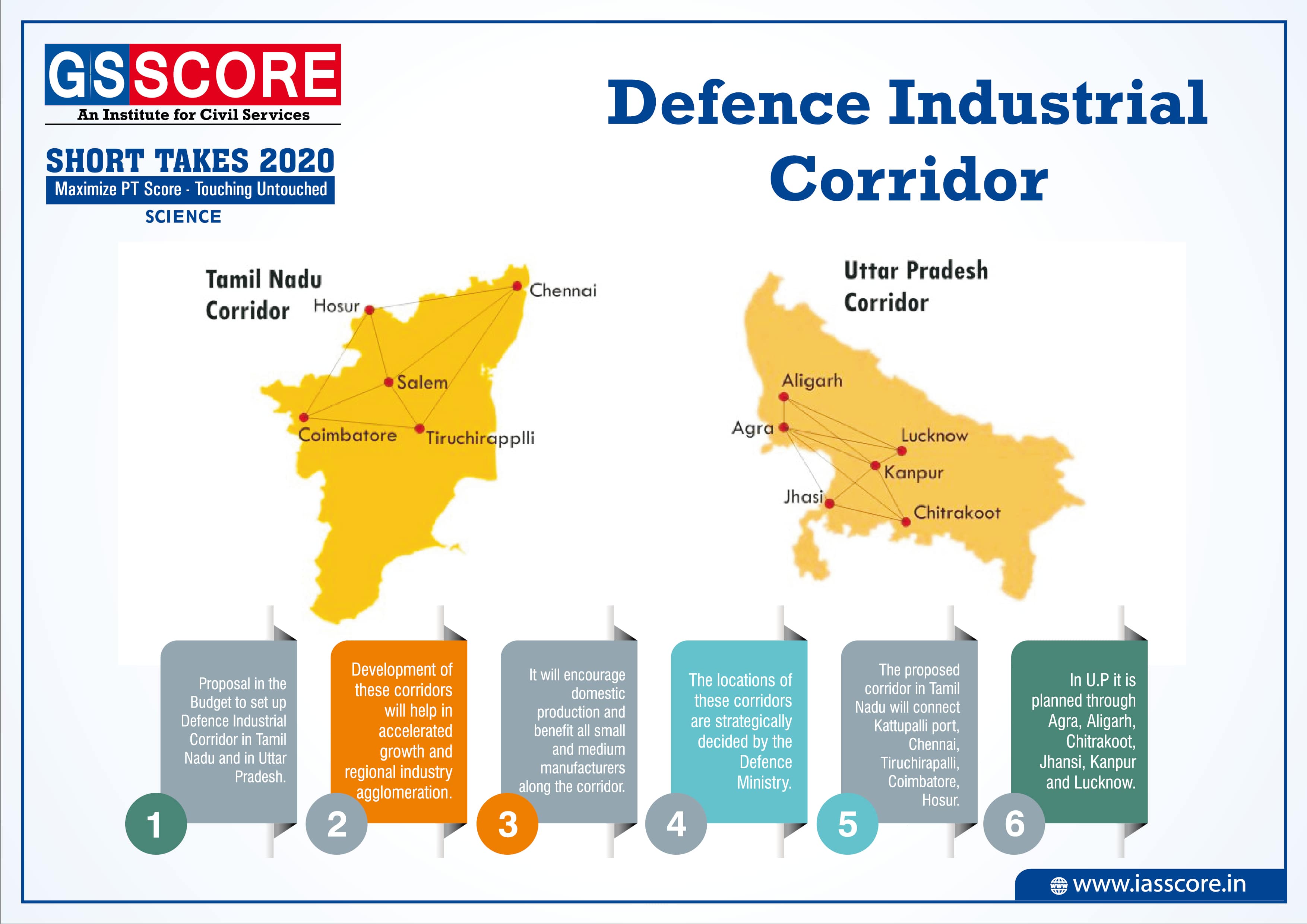
L98-59B
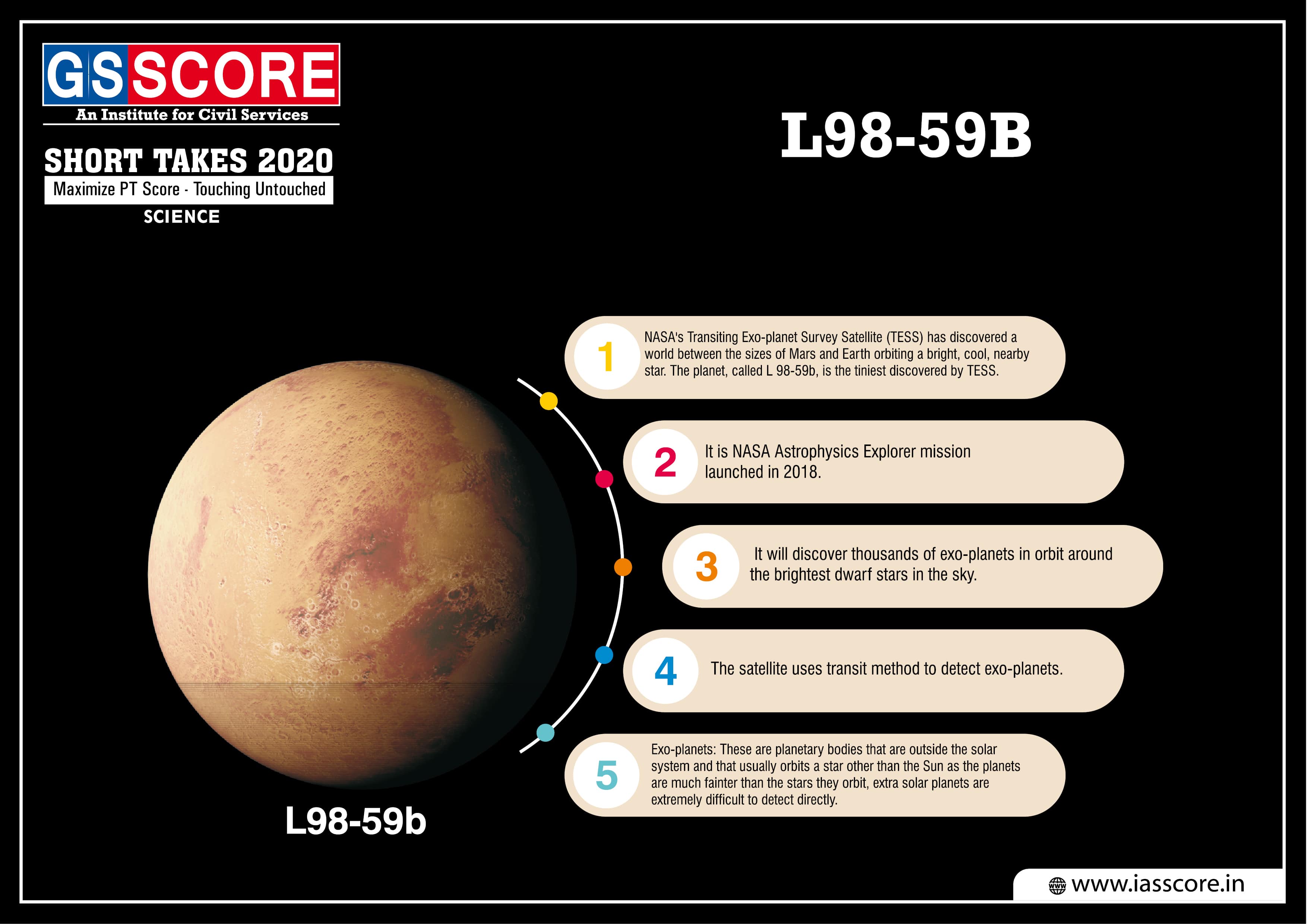
INS Sagardhwani



